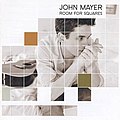Top Qs
Timeline
Chat
Perspective
Room for Squares
2001 studio album by John Mayer From Wikipedia, the free encyclopedia
Remove ads
Room for Squares is the debut studio album by American singer-songwriter and guitarist John Mayer, originally released on June 5, 2001, and re-released on September 18, 2001, by both Aware and Columbia Records. Upon its release, it peaked at number 8 on the US Billboard 200 and received generally positive reviews from critics. It earned Mayer a Grammy Award for Best Male Pop Vocal Performance for the single "Your Body Is a Wonderland".
Room for Squares is Mayer's best-selling album to date, having sold over 4,484,000 copies in the United States as of July 2014.[6]
Remove ads
Background
Summarize
Perspective
The album's title is a reference to Hank Mobley's No Room for Squares album.[7] All songs from the album are written by Mayer; three songs, "No Such Thing", "Neon", and "Love Song for No One", were co-written with Clay Cook. The first two of these, along with "My Stupid Mouth" and "Back to You", originally appeared on Mayer's 1999 EP Inside Wants Out. The songs are largely based on Mayer's personal experiences.[8]
Through constant shows, including in the Atlanta-area Eddie's Attic, Mayer's reputation began to build. In March, an acquaintance of Mayer's, a lawyer, sent an EP to Gregg Latterman at Aware Records.[9][10] After including him in the Aware Festival concerts and having his songs included on Aware compilations, in early 2001, Aware released Room for Squares as an internet-only album. During that time, Aware signed a deal with Columbia Records that gave Columbia first pick in signing Aware artists, and so in September 2001, Columbia remixed and re-released Room for Squares.[11] As part of the major label "debut", the album's artwork was updated, and the track "3x5" was added, which did not appear on the original as the recording was not yet complete at the time. The re-release included reworked studio versions of the first four songs from his indie album, Inside Wants Out.[12] The cover art for the most recent release of Room for Squares features a periodic table design beginning from the back cover which continues to the front cover, ending at the right-side.
The album was relatively unknown at its time of release, but it became more well known through word of mouth and John's touring,[8] and reached number one Billboard's Heatseekers chart by March 2002.[13] By the end of that year, Room for Squares had spawned several radio hits, including "No Such Thing", "Your Body Is a Wonderland", and ultimately, "Why Georgia" (a radio-only single).
Remove ads
Reception
Summarize
Perspective
By April 2002, Room for Squares had seen increases in eight of the previous nine weeks, earning the Billboard 200's Greatest Gainer (from number 82 to 56)—a 36 percent surge.[22] The increase was attributed to combination of a March performance of The Tonight Show with Jay Leno and the radio-and-retail campaign launched in more than 10 markets where Mayer was receiving airplay.[22] It reached number seven on Billboard's Top Pop Catalog.[23] A steady seller, the album was certified platinum despite never being a top-ten hit.[24]
Anthony DeCurtis for Rolling Stone gave the album four out of five stars, calling it "irresistible".[7] PopMatters gave an unfavorable review, saying "It doesn't offend, nor does it attempt to make itself too exciting for the most part."[25] Robert Christgau said that composition lyrics like "She keeps a toothbrush at my place/As if I had the extra space" on "City Love" are an improvement over Norah Jones.[16]
By the end of 2002, Room for Squares had spawned several radio hits, including, "No Such Thing", "Your Body Is a Wonderland", and, ultimately, "Why Georgia", which was released as a CD single six weeks before the follow-up album, Heavier Things, was released in 2003.
In 2003, Mayer won a Grammy for Best Male Pop Vocal Performance for "Your Body Is a Wonderland". In his acceptance speech he remarked, “This is very, very fast, and I promise to catch up.”[26] He referred to himself as being sixteen, a remark that many mistook to mean that he was only sixteen years old at the time.[27]
Remove ads
Track listings
Summarize
Perspective
All tracks are written by John Mayer, except where noted.
Note: On the Columbia re-release, "St. Patrick's Day" is consistently listed as track 14; track 13 is an unlisted song with a duration of 0:04, and sometimes even 0:00. And on the Columbia re-released version, the drum has been removed, but on the Aware Records version the drum is present through the entire song.
Alternative covers
The album's cover for its initially planned June 2001 release in the United States and its Japan release had alternative covers.
- Original release cover art
- Japanese release cover art
Additionally the main album cover had a single dividing line changed between releases.
- Askew line pictured left
Personnel
Summarize
Perspective
All track numbers correlate with those on the Columbia release of the album.
Musicians
|
|
Production
- Jack Joseph Puig – mixing on tracks 1, 3, 4, 7, 8, 9 and 10
- Jeff Juliano – mixing on tracks 2, 5, 6, 11, 12 and 14; engineering; Pro Tools engineering
- Scott Hull – mastering
- John Mark Painter – strings arrangements
- Greg Di Gesu – assistant engineer
- Dan Fallon – artwork
- Alex Fallon – artwork
- Joshua Kessler – photography (Columbia release)
Remove ads
Charts
Remove ads
Certifications
Remove ads
References
External links
Wikiwand - on
Seamless Wikipedia browsing. On steroids.
Remove ads




